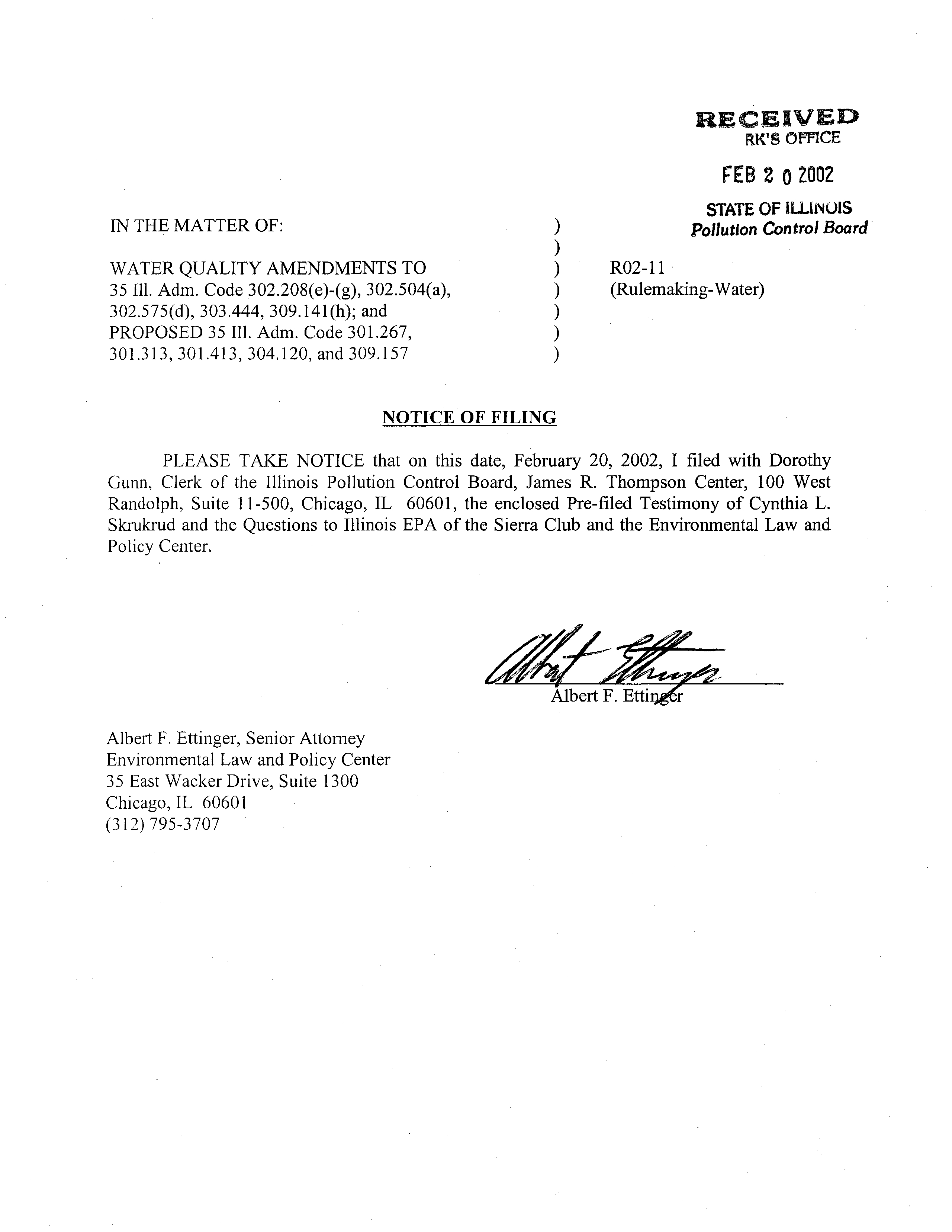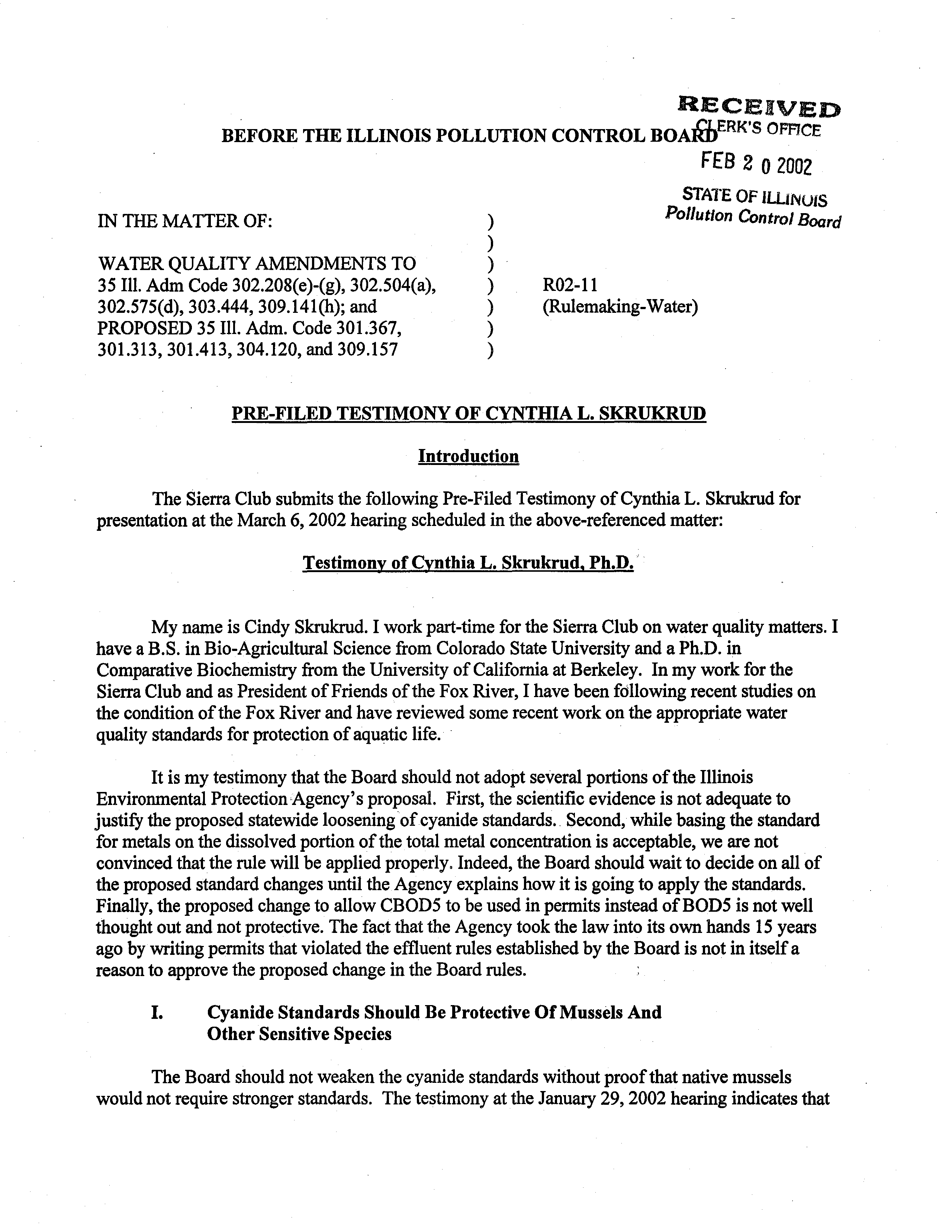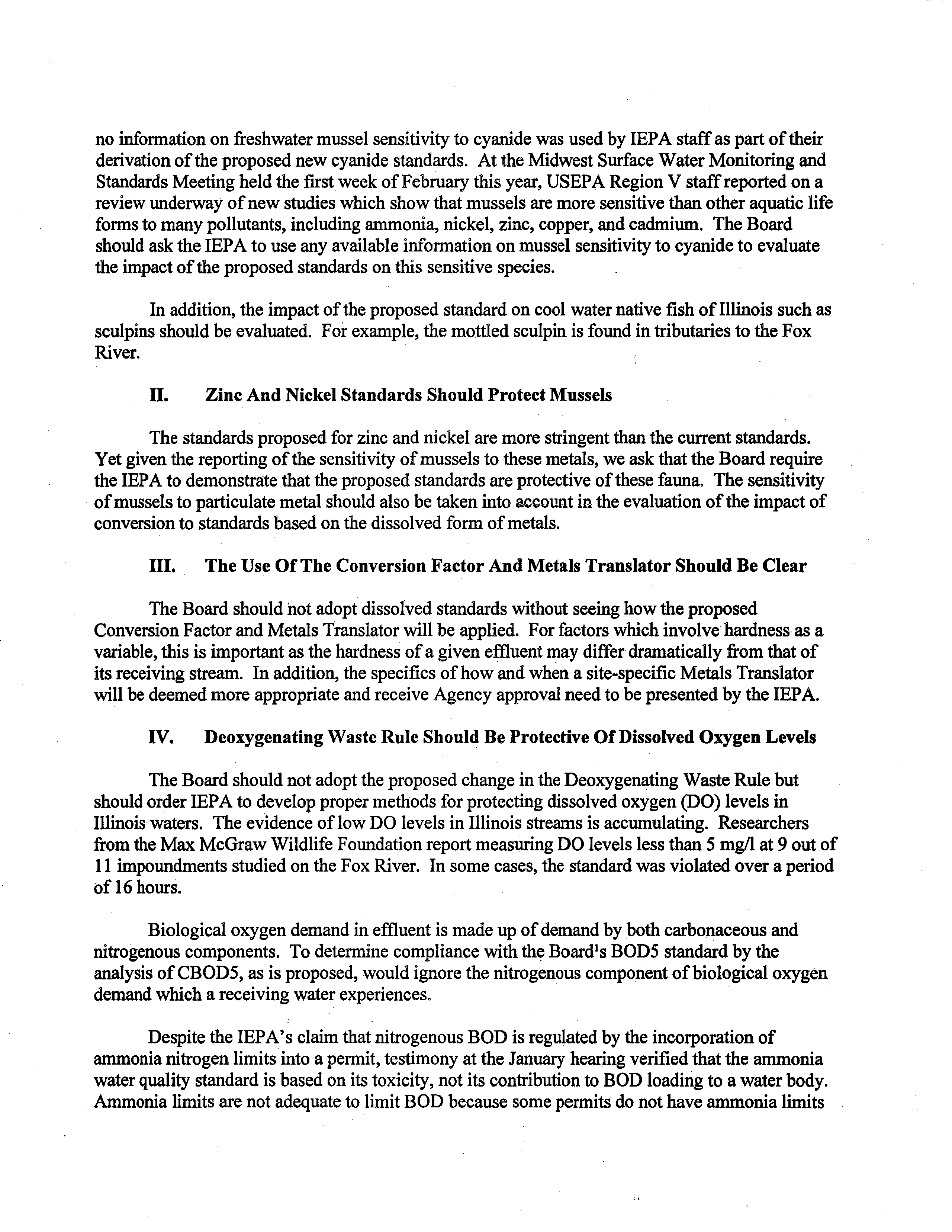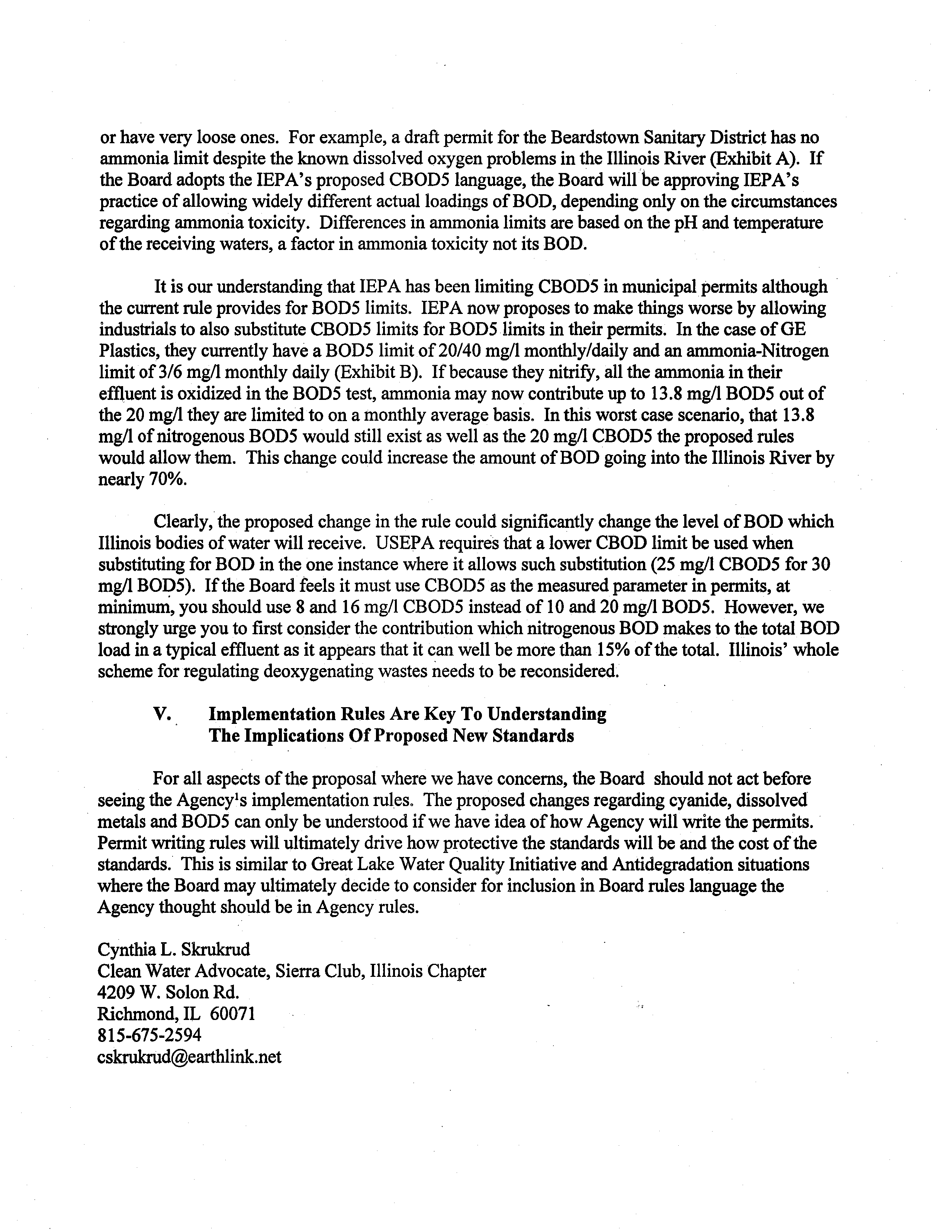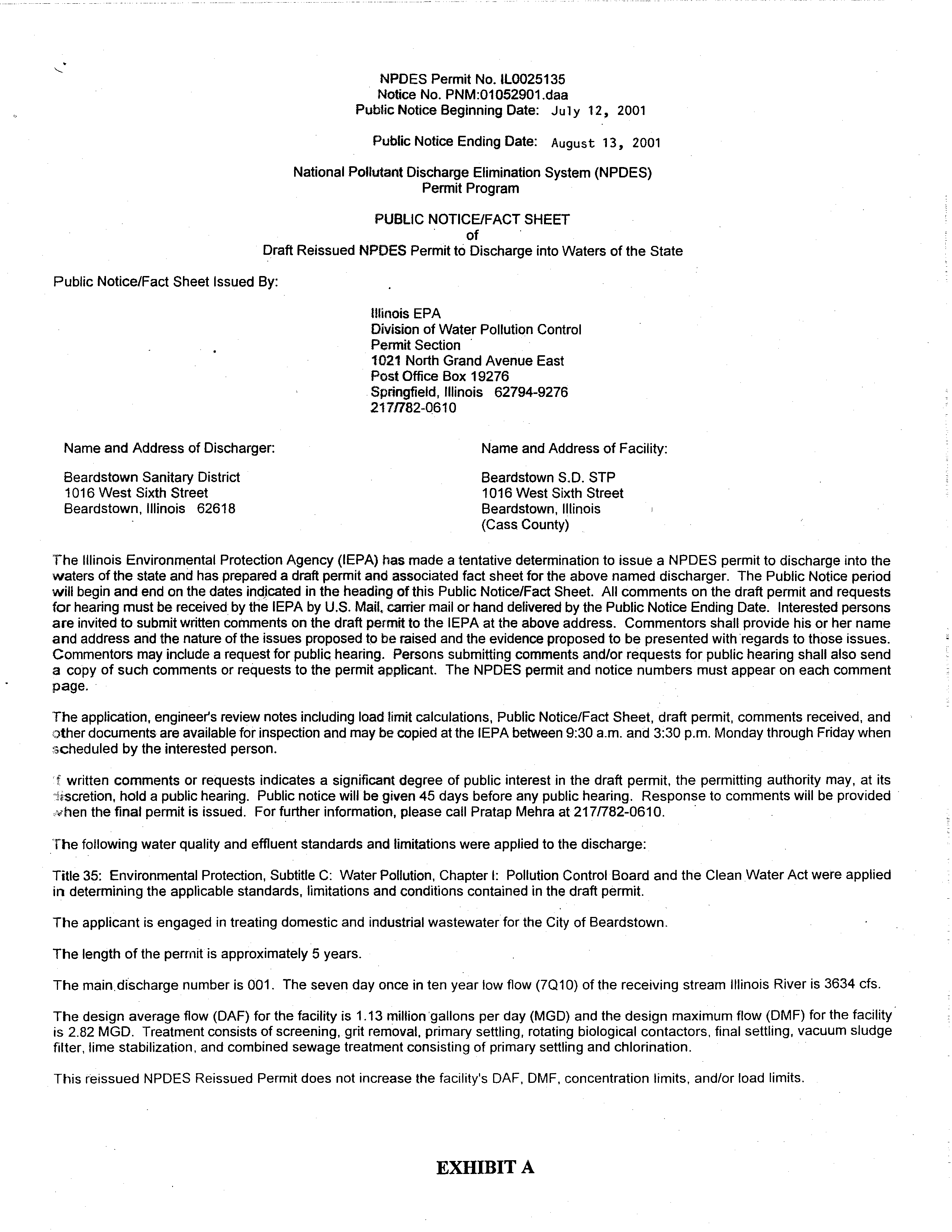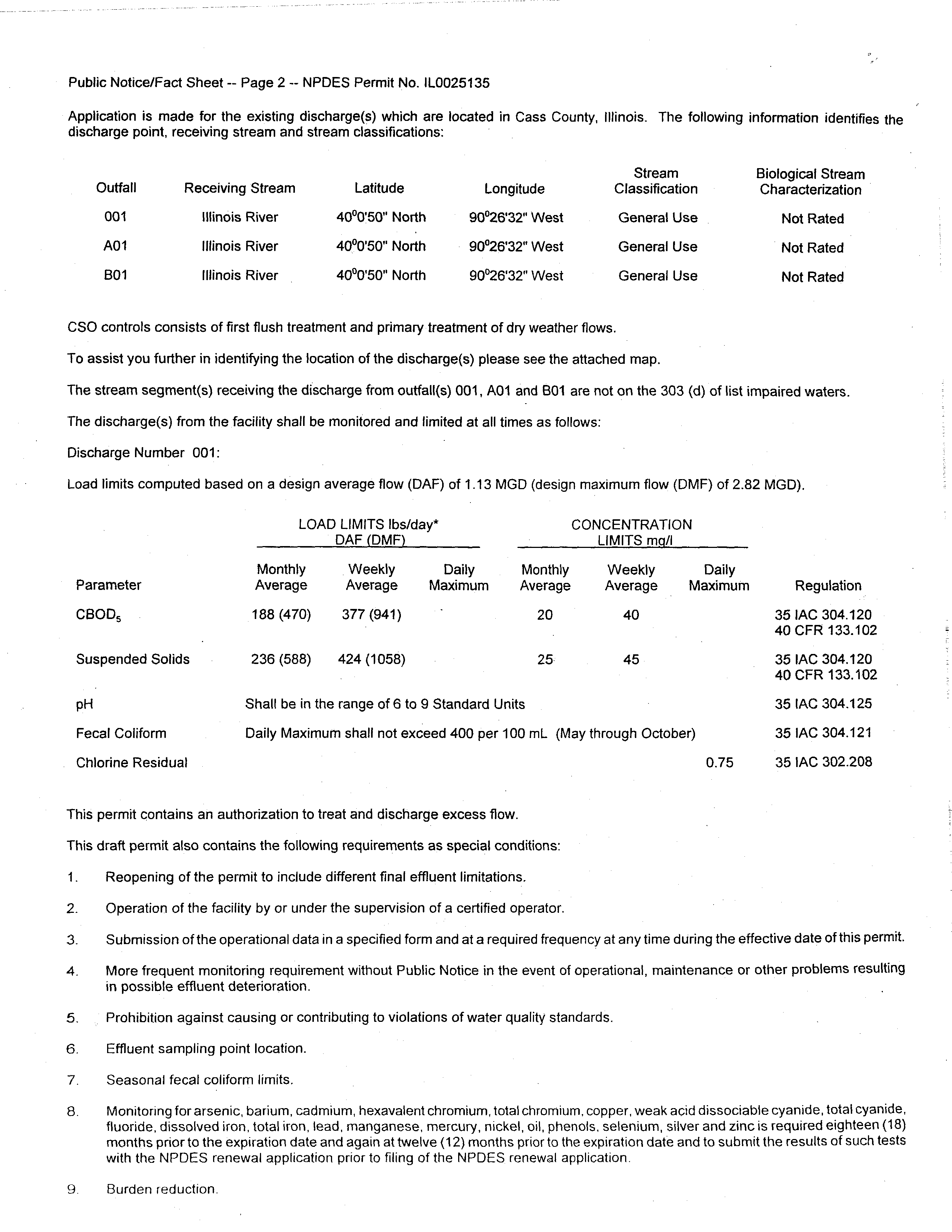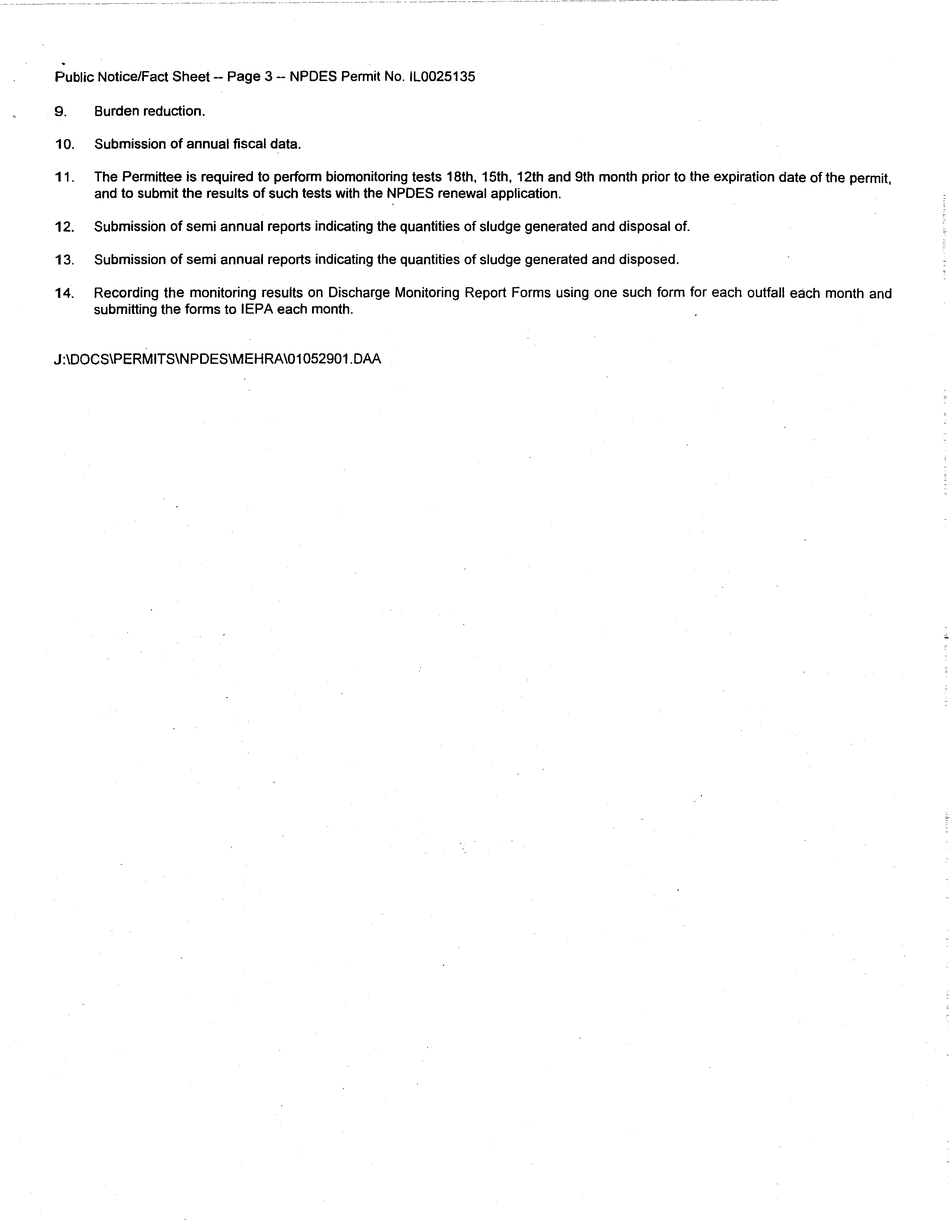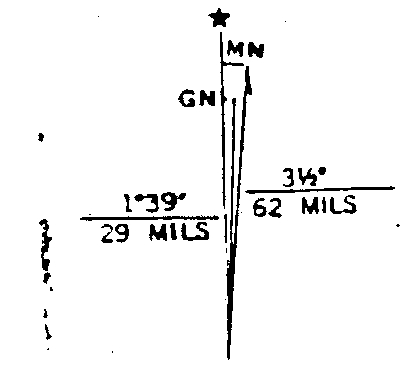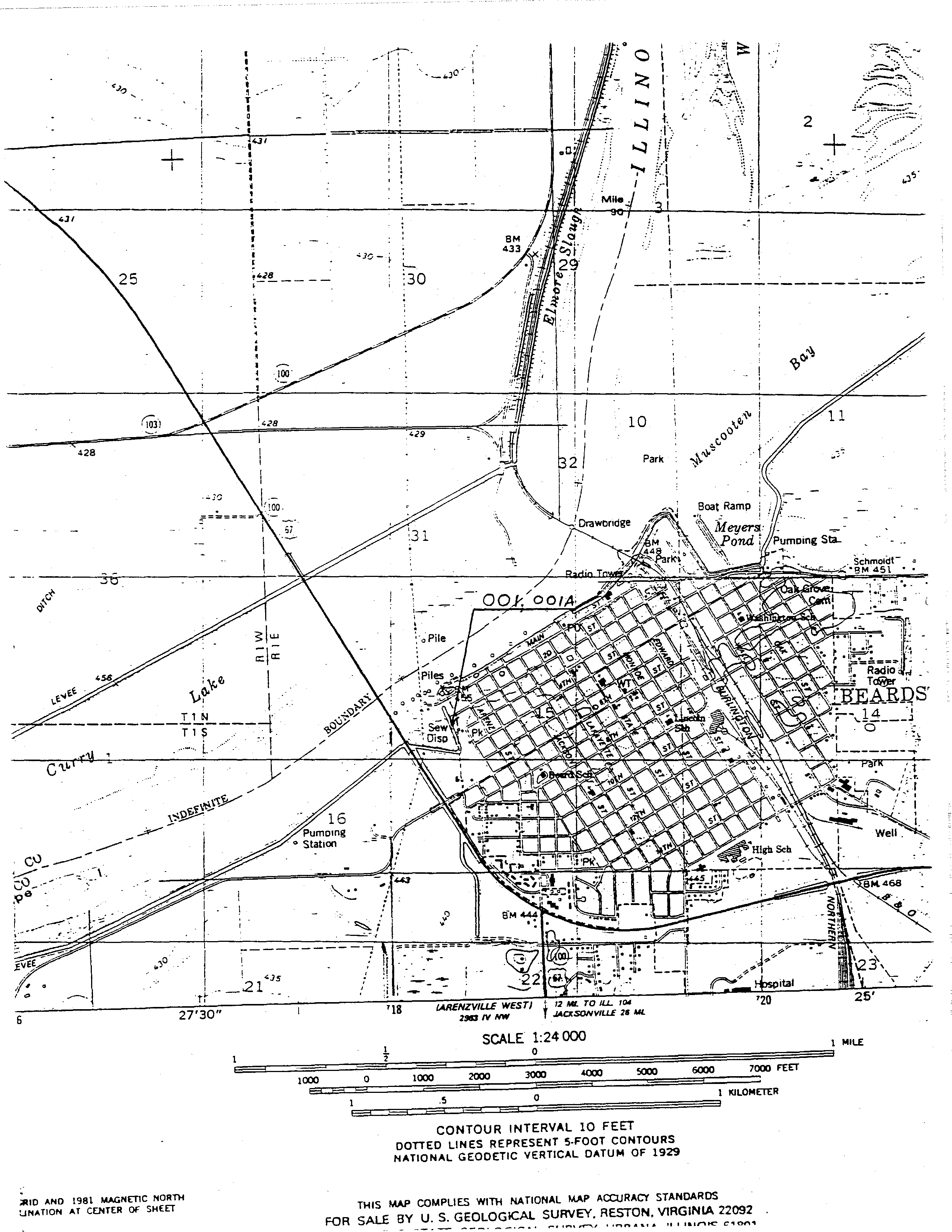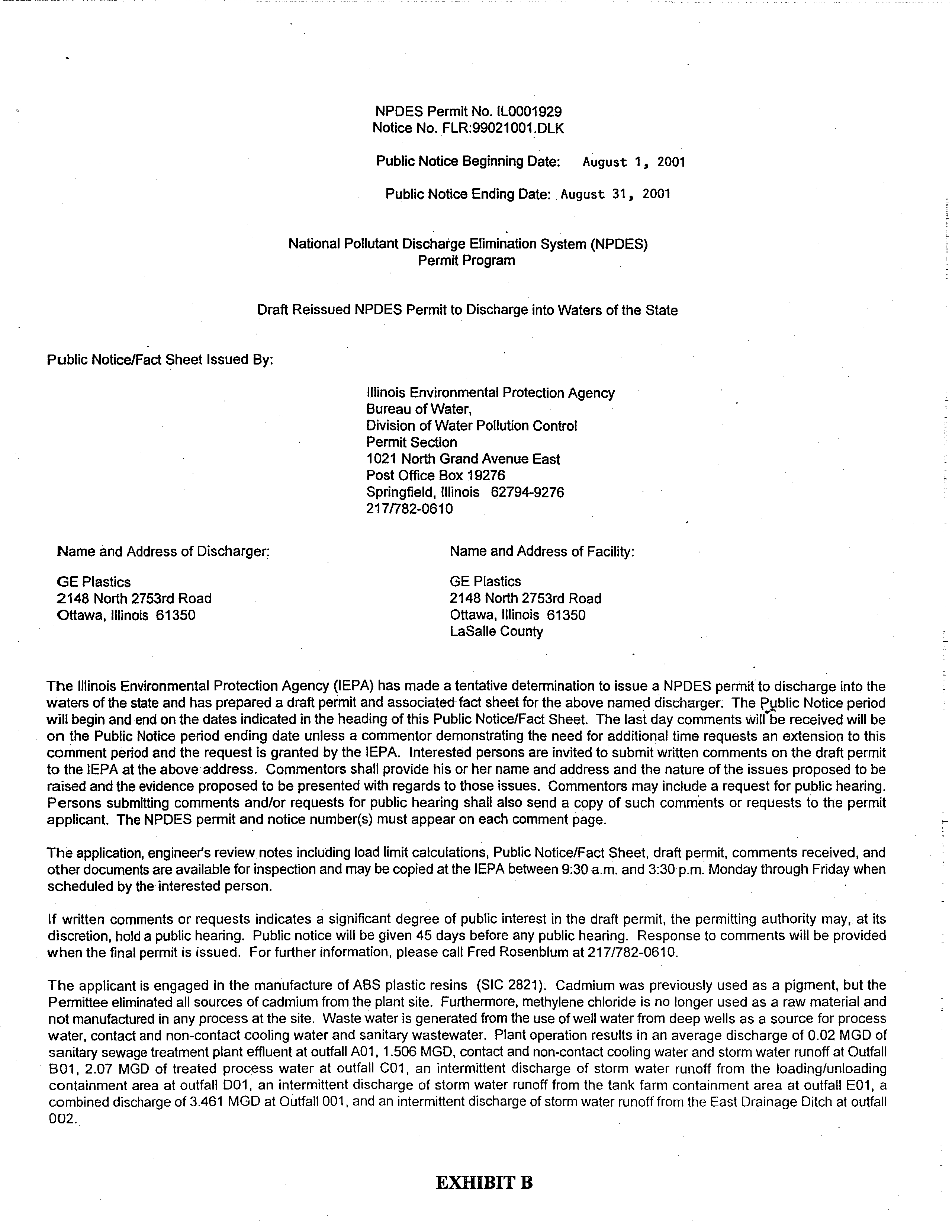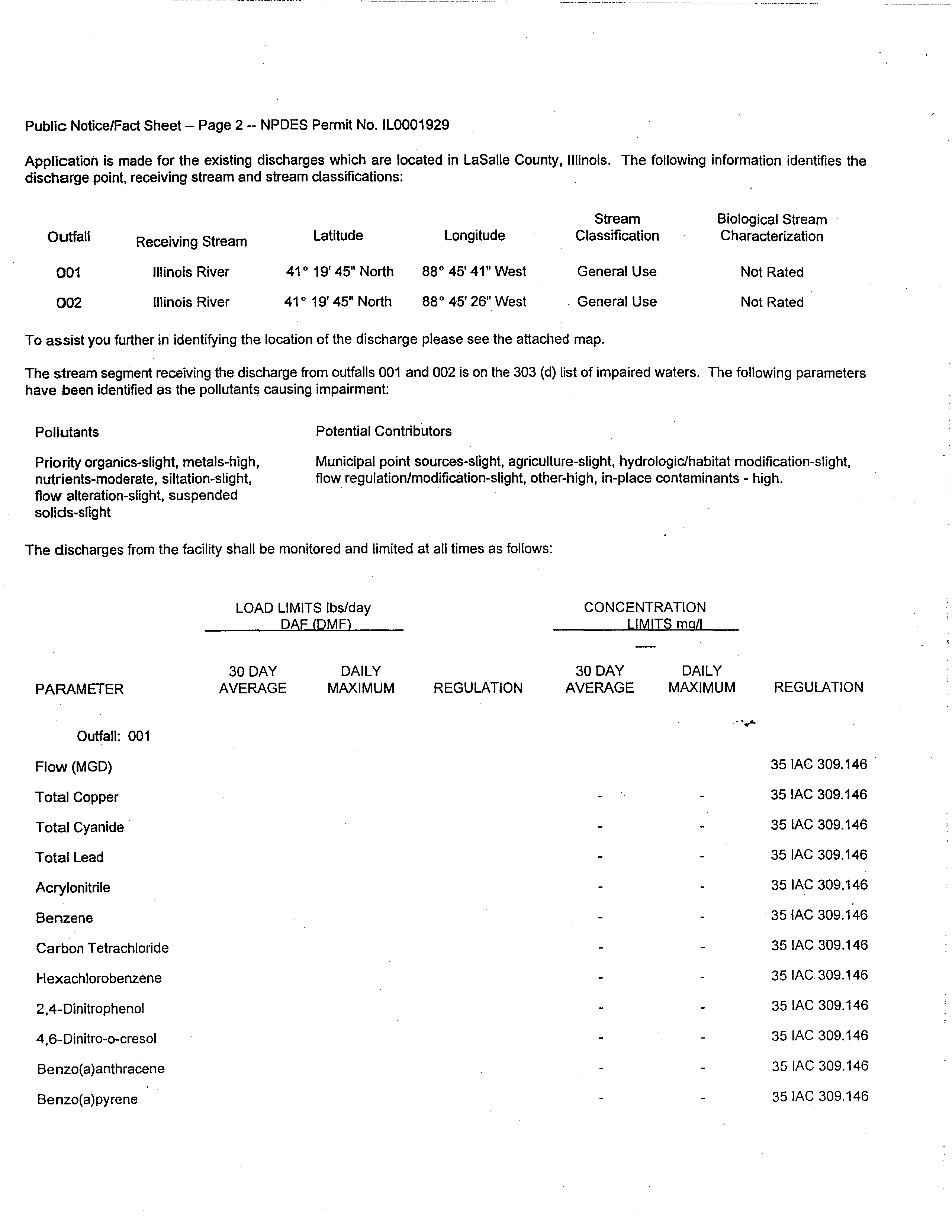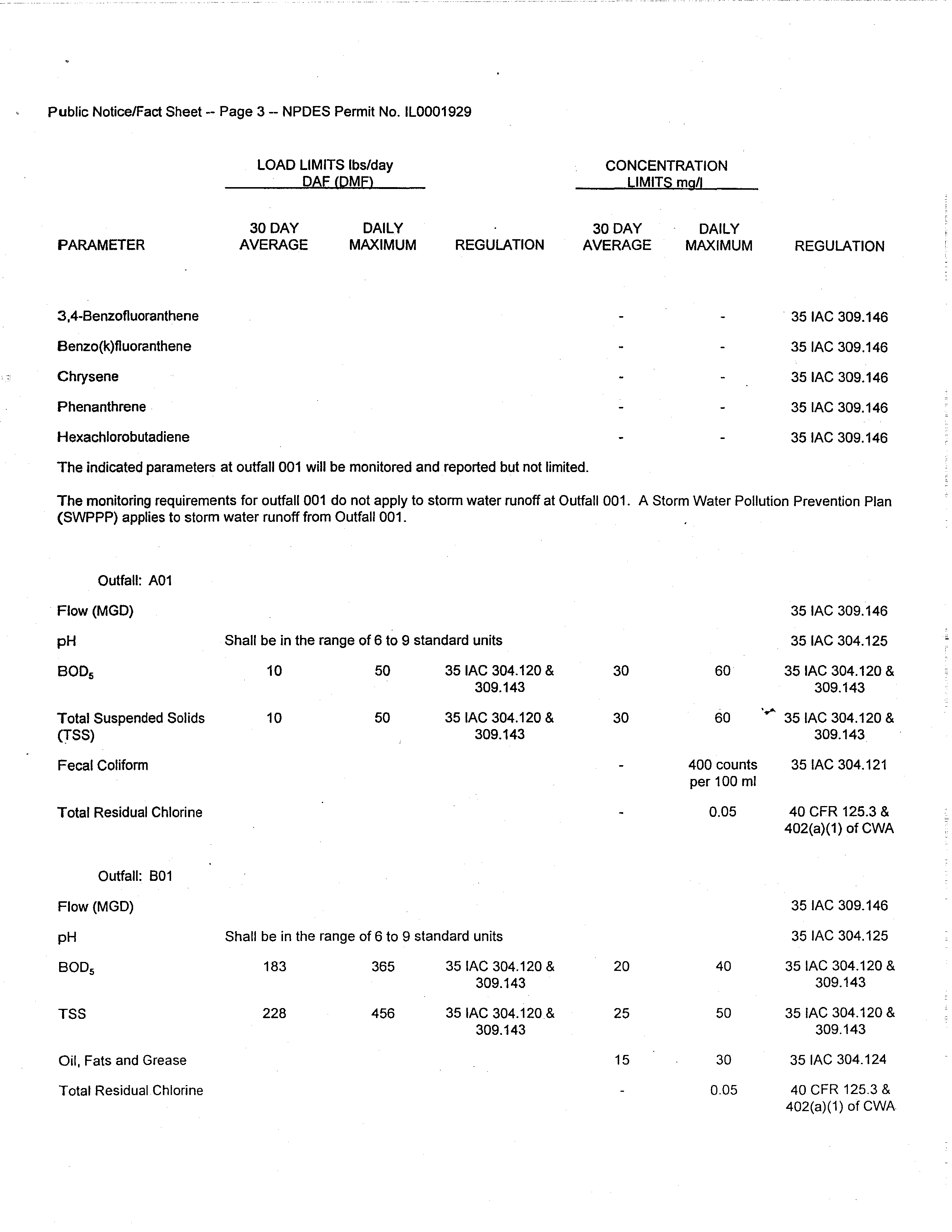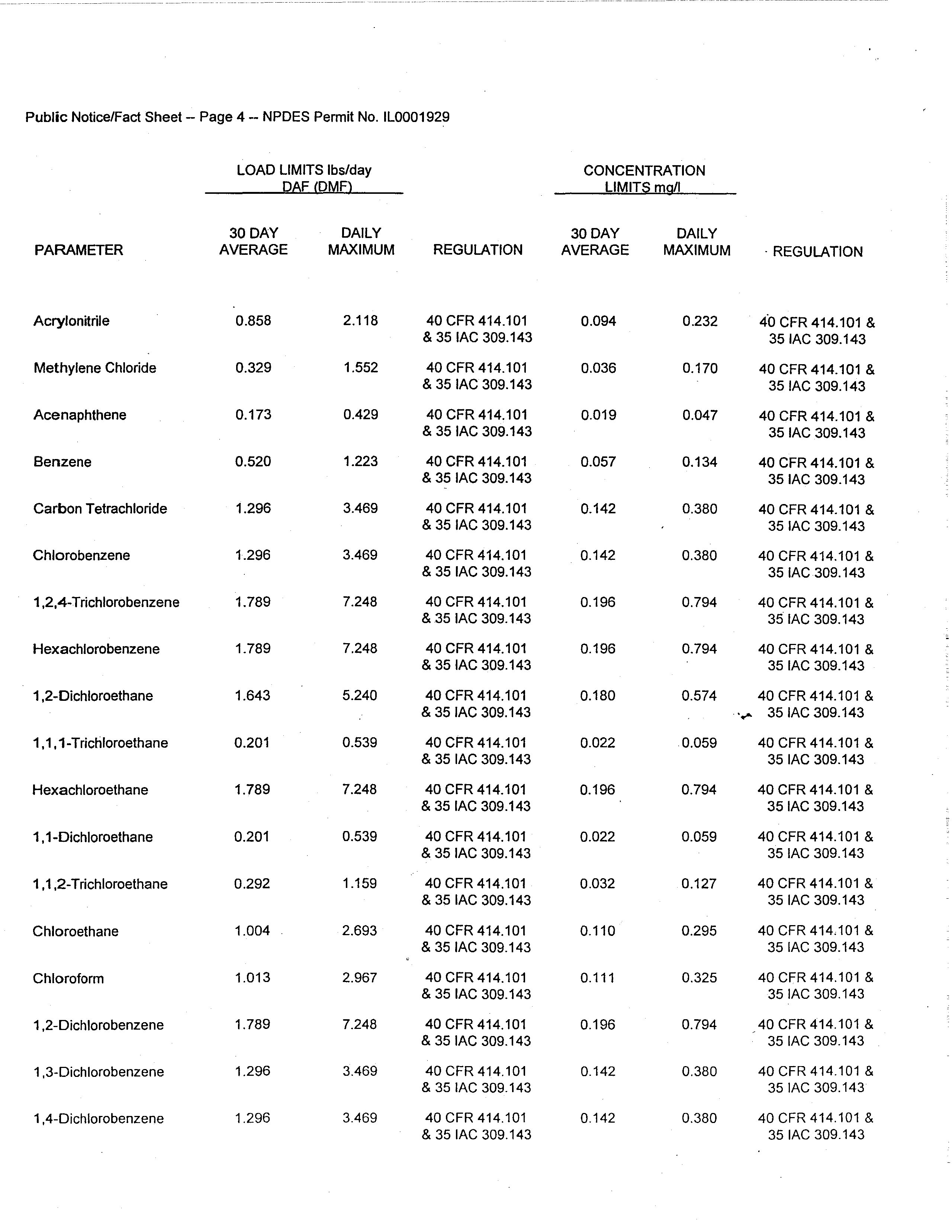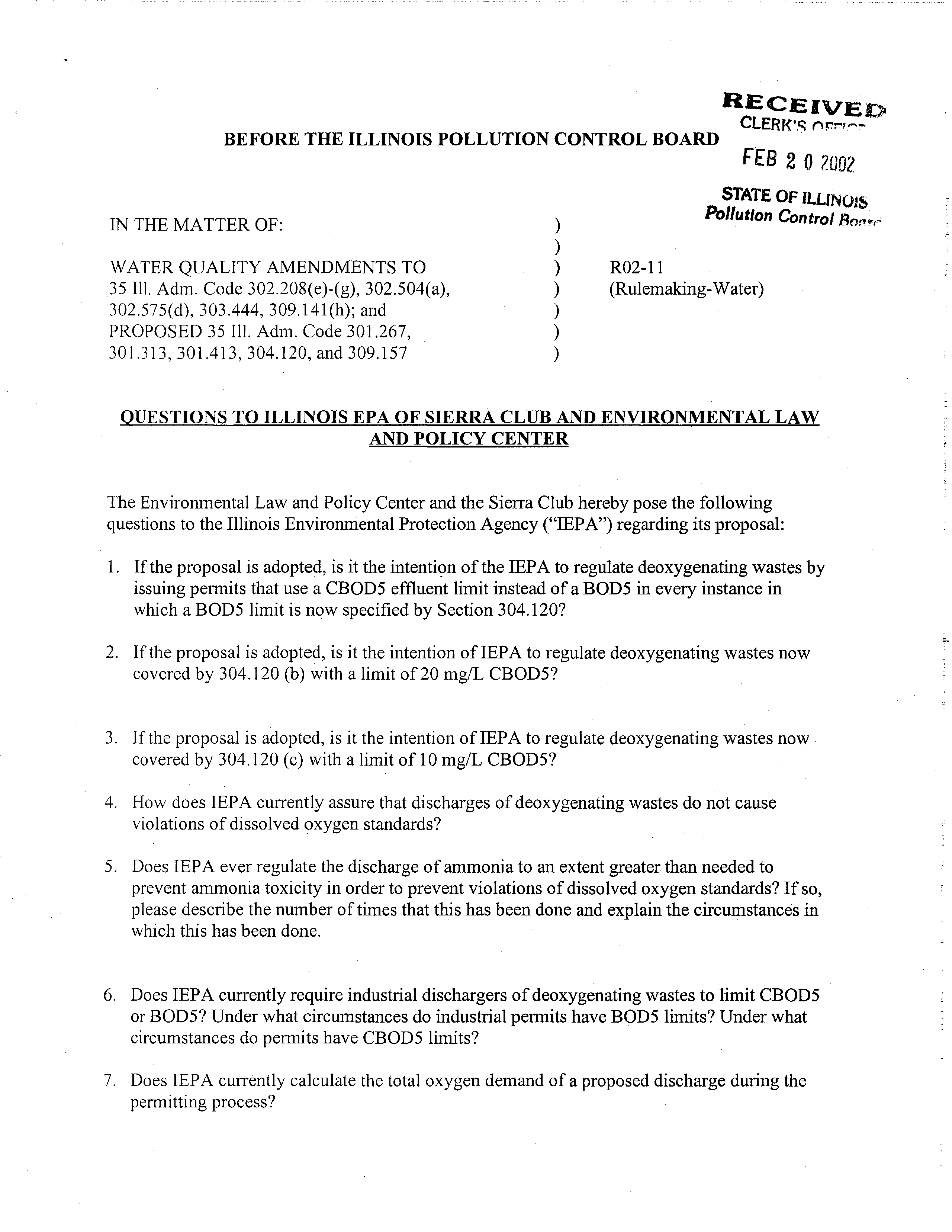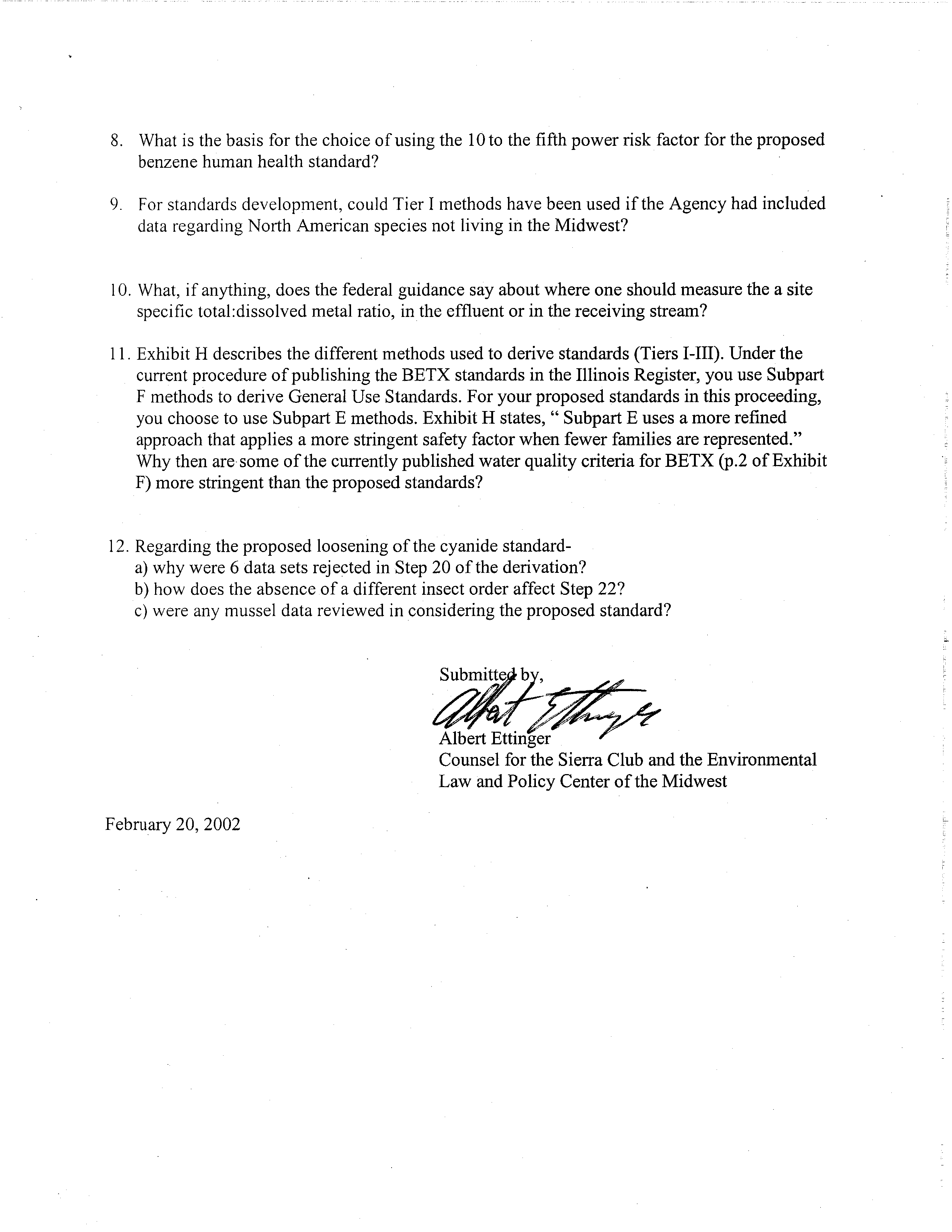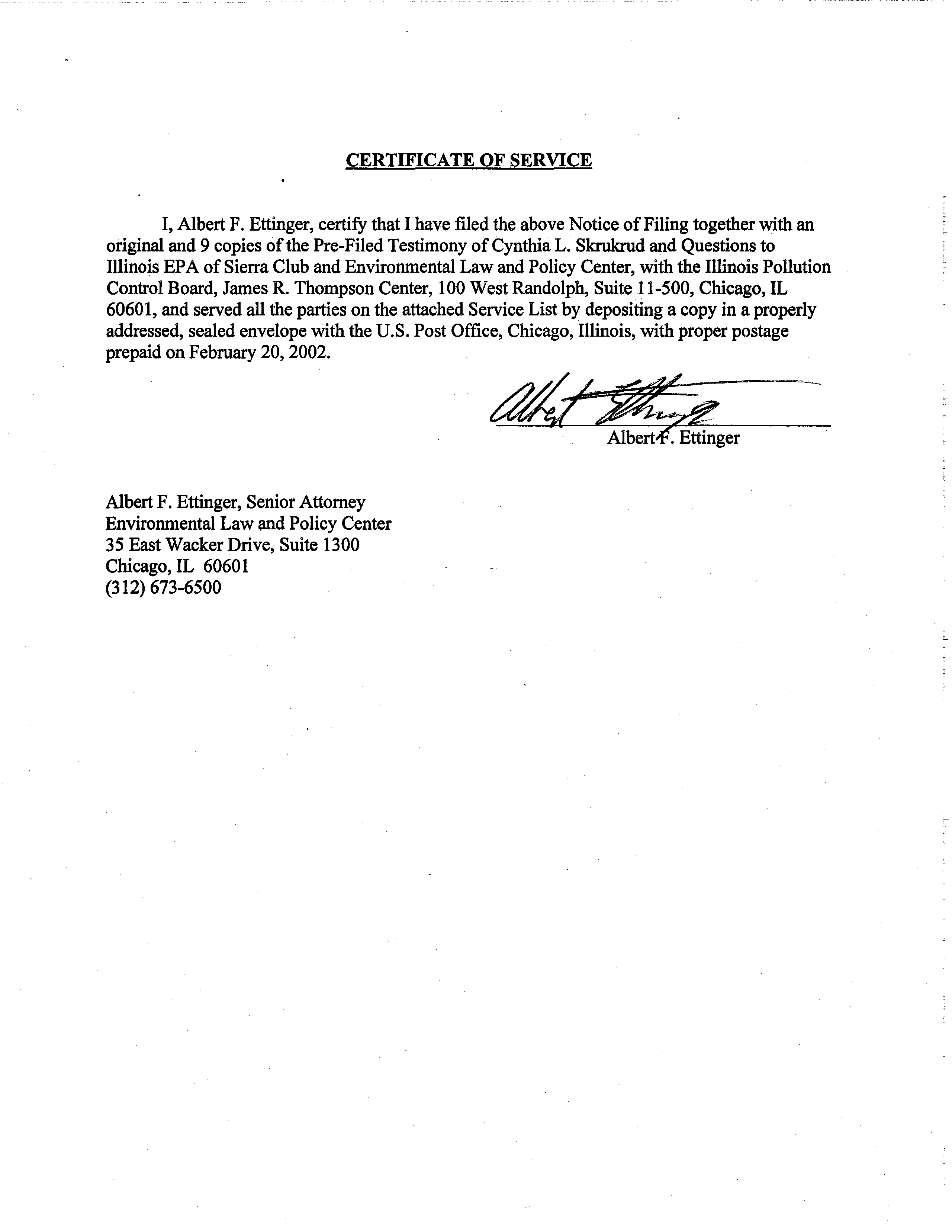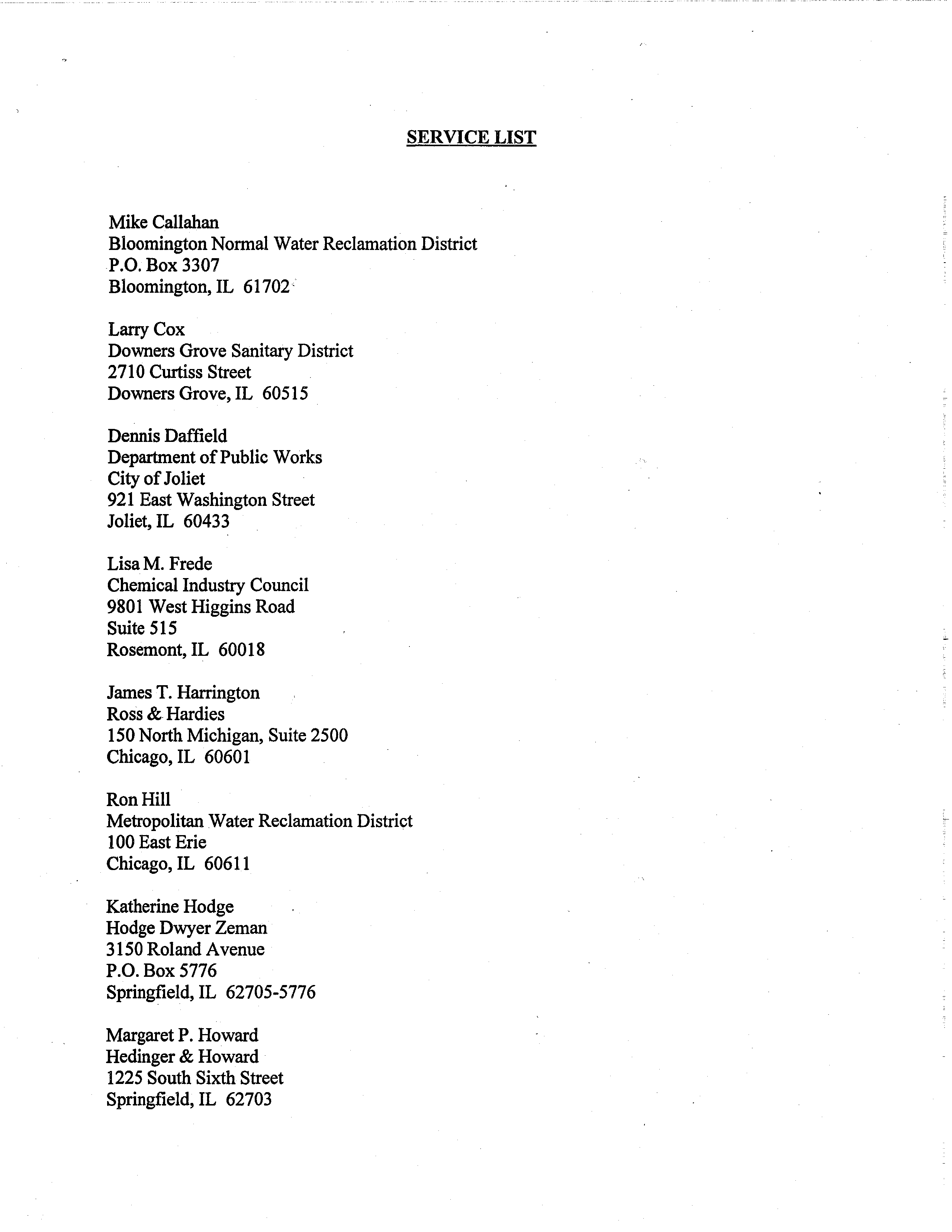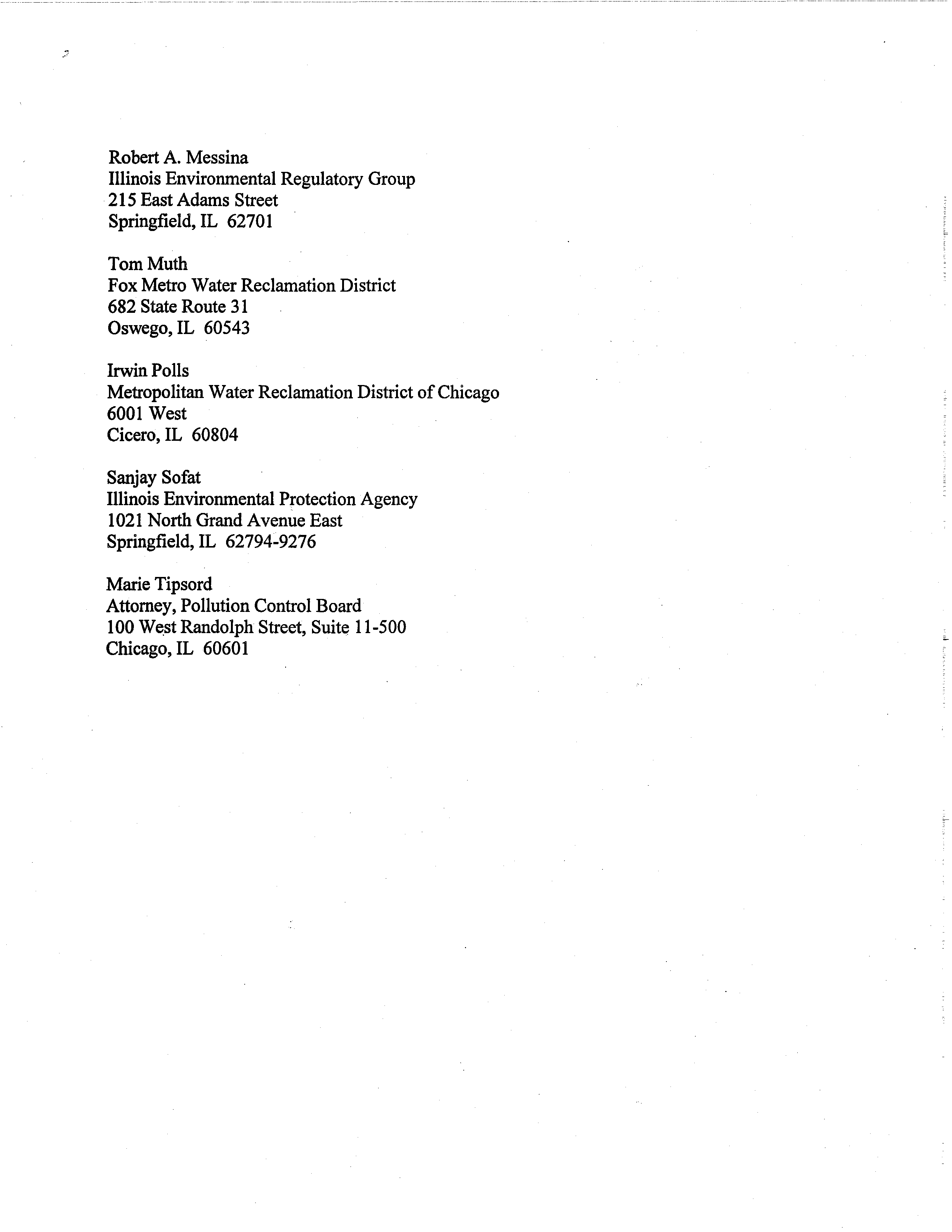RECEIVED
LU~SOF~1CE
FEB 2 0 ZOO2
STATE OF
ILLtNOiS
Pollution Control Board
R02-11
(Rulemaking-Water)
IN THE MATTER OF:
WATER QUALITY AMENDMENTS TO
35
Iii. Adm. Code 302.208(e)-(g), 302.504(a),
302.575(d),
303.444, 309.141(h); and
PROPOSED 35 Iii. Adm. Code 301.267,
301.313, 301.413, 304.120, and 309.157
NOTICE OF FILING
PLEASE TAKE NOTICE that on this date, February 20, 2002, I filed with Dorothy
Gunn, Clerk of the Illinois Pollution Control Board, James R. Thompson Center, 100 West
Randolph, Suite 11-500, Chicago, IL 60601, the enclosed Pre-filed Testimony of Cynthia L.
Skrukrud and the Questions to Illinois EPA of the Sierra Club and the Environmental Law and
Policy Center.
AlbertF.Etti
r
Albert F. Ettinger, Senior Attorney
Environmental Law and Policy Center
35 East Wacker Drive, Suite 1300
Chicago, IL 60601
(312) 795-3707
)
)
)
)
)
)
)
RECE!VED
BEFORE THE ILLINOIS POLLUTION CONTROL BOAM)ERKS OFFICE
STATE
FEB2
OF02002
ILLIMJIS
IN THE MATTER OF:
)
Pollutiofl Control Board
)
WATER QUALITY AMENDMENTS TO
)
35
Ill. Adm Code 302.208(e)-(g), 302.504(a),
)
R02-1 1
302.575(d),
303.444, 309.141(h); and
)
(Rulemaking-Water)
PROPOSED
35
Ill. Adm. Code 301.367,
)
301.313, 301.413, 304.120, and 309.157
)
PRE-FILED TESTIMONY OF CYNTHIA L. SKRUKRUD
Introduction
The Sierra Club submits the following Pre-Filed Testimony ofCynthia L. Skrukrud for
presentation at the March 6, 2002 hearing scheduled in the above-referenced matter:
Testimony of Cynthia L. Skrukrud~Ph.D.
My name is Cindy Skrukrud. I work part-time for the Sierra Club on water quality matters. I
have a B.S. in Bio-Agricultural Science from Colorado State University and a Ph.D. in
Comparative Biochemistry from the University ofCalifornia at Berkeley. Inmy work forthe
Sierra Club and as President ofFriends ofthe Fox River, I have been following recent studies on
the condition ofthe Fox River and have reviewed some recent work on the appropriate water
quality standards for protection ofaquatic life.
It is my testimony that the Board should not adopt several portions ofthe Illinois
Environmental Protection Agency’s proposal. First, the scientific evidence is not adequate to
justify the proposed statewide loosening ofcyanide standards. Second, while basing the standard
for metals on the dissolved portion ofthe total metal concentration is acceptable, we are not
convinced that the rule will be applied properly. Indeed, the Board should wait to decide on all of
the proposed standard changes until the Agency explains how it is going to apply the standards.
Finally, the proposed change to allow CBOD5 to be used in permits instead of BOD5 is not well
thoughtout and not protective. The fact that the Agency took the law into its own hands 15 years
ago by writingpermits that violated the effluent rules established by the Board is not in itselfa
reason to approve the proposed change in the Board rules.
I.
Cyanide Standards Should Be Protective Of Mussels
And
Other Sensitive Species
The Board should not weakenthe cyanide standards without proofthat native mussels
would not require stronger standards. The testimony at the January 29, 2002 hearing indicates that
no information on freshwater mussel sensitivity to cyanide was used by IEPA staff as part oftheir
derivation ofthe proposed new cyanide standards. At the Midwest Surface Water Monitoring and
Standards Meeting held the first week ofFebruary this year, USEPA Region V staffreported on a
review underway ofnew studies which show that mussels are more sensitive than other aquatic life
forms to many pollutants, including ammonia, nickel, zinc, copper, and cadmium. The Board
should ask the IEPA to use any available information on mussel sensitivity to cyanide to evaluate
the impact ofthe proposed standards on this sensitive species.
In addition, the impact ofthe proposed standard on cool water native fish ofIllinois such as
sculpins should be evaluated. For example, the mottled sculpin. is found in tributaries to the Fox
River.
II.
Zinc And Nickel Standards Should Protect Mussels
The standards proposed for zinc and nickel are more stringent than the current standards.
Yet given the reporting ofthe sensitivity ofmussels to these metals, we ask that the Board require
the IEPA to demonstrate that the proposed standards are protective of these fauna, The sensitivity
ofmussels to particulate metal should also be taken into account in the evaluationofthe impact of
conversion to standards based on the dissolved form ofmetals.
III.
The Use Of The Conversion Factor And Metals Translator Should Be Clear
The Board should not adopt dissolved standards without seeing how the proposed
Conversion Factor and Metals Translator will be applied. For factors which involve hardness as a
variable, this is important as the hardness of a given effluent may differ dramatically from that of
its receiving stream. In addition, the specifics ofhow and when a site-specific Metals Translator
will be deemed more appropriate and receive Agency approval need to be presented by the IEPA.
IV.
Deoxygenating Waste Rule Should Be Protective Of Dissolved Oxygen Levels
The Board should not adopt the proposed change in the Deoxygenating Waste Rule but
should order IEPA to develop proper methods for protecting dissolved oxygen (DO) levels in
Illinois waters. The evidence oflow DO levels in Illinois streams is accumulating. Researchers
from the Max McGraw Wildlife Foundation report measuring DO levels less than
5
mg/i at 9 out of
11 impoundments studied on the Fox River. In some cases, the standard was violated over a period
of 16 hours.
Biological oxygen demand in effluent is made up ofdemand by both carbonaceous and
nitrogenous components. To determine compliance with the Board’s BOD5 standard by the
analysis ofCBOD5, as is proposed, would ignore the nitrogenous component ofbiological oxygen
demand which a receiving waterexperiences.
Despite the IEPA’s claim that nitrogenous BOD is regulated by the incorporation of
ammonia nitrogen limits into a permit, testimony at the January hearing verified that the ammonia
water quality standard is based on its toxicity, not its contribution to BOD loading to a waterbody.
Ammonia limits are not adequate to limit BOD because some permits do not have ammonia limits
orhave very loose ones. For example, a draft permit forthe Beardstown Sanitary District has no
ammonia limit despite the known dissolved oxygen problems in the Illinois River (Exhibit A). If
the Board adopts the IEPA’s proposed CBOD5 language, the Board will be approving IEPA’s
practice ofallowing widely different actual loadings ofBOD, depending only on the circumstances
regarding ammonia toxicity. Differences in ammonia limits are based on the pH and temperature
ofthe receiving waters, a factor in ammonia toxicity not its BOD.
It is our understanding that IEPA has been limiting CBOD5 in municipal permits although
the current rule provides for BOD5 limits. IEPA now proposes to make things worse by allowing
industrials to also substitute CBOD5 limits for BOD5 limits in their permits. Inthe case ofGE
Plastics, they currently have a BOD5 limit of20/40 mg/l monthly/daily and an ammonia-Nitrogen
limit of3/6 mg/i monthly daily (Exhibit B). Ifbecause they nitrify, all the ammonia in their
effluent is oxidized in the BOD5 test, ammonia may now contribute up to 13.8 mg/i BOD5 out of
the 20 mg/l they are limited to on a monthly average basis. In this worst case scenario, that 13.8
mg/l ofnitrogenous BOD5 would still exist as well asthe 20 mg/l CBOD5 the proposed rules
would allow them. This change could increase the amount ofBOD going into the Illinois River by
nearly 70.
Clearly, the proposed change in the rule could significantly change the level ofBOD which
Illinois bodies ofwater will receive. USEPA requires that a lower CBOD limit be used when
substituting for BOD in the one instance where it allows suchsubstitution (25 mg/l CBOD5 for 30
mg/l BOD5). Ifthe Board feels it must use CBOD5 as the measuredparameter in permits, at
minimum, you should use 8 and 16 mg/i CBOD5 instead of 10 and 20 mg/l BOD5. However, we
strongly urge you to first consider the contribution which nitrogenous BOD makes to the total BOD
load in a typical effluent as it
appears that it can well be more than
15
ofthe total. Illinois’ whole
scheme forregulating deoxygenating wastes needs to be reconsidered.
V.
Implementation Rules Are Key To Understanding
The Implications Of Proposed New Standards
For all aspects of
the proposal where we have concerns, the Board should not act before
seeing the Agency’s implementation
rules, The proposed changes regarding cyanide, dissolved
metals and BOD5 can only be understood if we have idea ofhowAgency will write the permits.
Permit writing rules will ultimately drive how protective the standards will be and the cost ofthe
standards. This is similar to Great Lake Water Quality Initiative and Antidegradation situations
where the Board may ultimately decide to consider for inclusion in Board rules language the
Agency thoughtshould be in Agency rules.
Cynthia L. Skrukrud
Clean Water Advocate, Sierra Club, Illinois Chapter
4209 W. Solon Rd.
Richmond, IL 60071
815-675-2594
csknikrud@earthlink.net
NPDES Permit No. 1L0025135
Notice No. PNM:01052901.daa
Public Notice Beginning Date: July 12, 2001
Public Notice Ending Date: August 13, 2001
National Pollutant Discharge Elimination System (NPDES)
Permit Program
PUBLIC NOTICE/FACT SHEET
of
Draft Reissued NPDES Permit to Discharge into Waters of the State
Public Notice/Fact Sheet Issued By:
Illinois EPA
Division of Water Pollution Control
Permit Section
1021 North Grand Avenue East
Post Office Box 19276
Springfield, Illinois 62794-9276
2171782-0610
Name and Address of Discharger:
Name and Address of Facility:
Beardstown Sanitary District
Beardstown S.D. STP
1016 West Sixth Street
1016 West Sixth Street
Beardstown, Illinois 62618
Beardstown, Illinois
(Cass County)
The Illinois Environmental Protection Agency (IEPA) has made a tentative determination to issue a NPDES permit to discharge into the
waters of the state and has prepared a draft permit and associated fact sheet for the above named discharger. The Public Notice period
will begin and end on the dates indicated in the heading of this Public Notice/Fact Sheet. All comments on the draft permit and requests
for hearing must be received by the IEPA by U.S. Mail, carrier mail or hand delivered by the Public Notice Ending Date. Interested persons
are invited to submit written comments on the draft permit to the IEPA at the above address. Commentors shall provide his or her name
and address and the nature of the issues proposed to be raised and the evidence proposed to be presented with regards to those issues.
Commentors may include a request for publiq hearing. Persons submitting comments and/or requests for public hearing shall also send
a copy of such comments or requests to the permit applicant. The NPDES permit and notice numbers must appear on each comment
page.
The application, engineer’s review notes including load limit calculations, Public Notice/Fact Sheet, draft permit, comments received, and
~therdocuments are available for inspection and may be copied at the IEPA between 9:30 a.m. and 3:30 p.m. Monday through Friday when
3cheduled by the interested person.
written comments or requests indicates a significant degree of public interest in the draft permit, the permitting authority may, at its
~tscretion,hold a public hearing. Public notice will be given 45 days before any public hearing. Response to comments will be provided
vhen the final permit is issued. For further information, please call Pratap Mehra at 21 7/782-0610.
The following water quality and effluent standards and limitations were applied to the discharge:
Title 35: Environmental Protection, Subtitle C: Water Pollution, Chapter I: Pollution Control Board and the Clean Water Act were applied
in determining the applicable standards, limitations and conditions contained in the draft permit.
The applicant is engaged in treating domestic and industrial wastewater for the City of Beardstown.
The length of the permit is approximately 5 years.
The maindischarge number is 001. The seven day once in ten year low flow (7Q10) of the receiving stream Illinois River is 3634 cfs.
The design average flow (DAF) for the facility is 1.13 million gallons per day (MGD) and the design maximum flow (DMF) for the facility
is 2.82 MGD. Treatment consists of screening, grit removal, primary settling, rotating biological contactors, final settling, vacuum sludge
filter, lime stabilization, and combined sewage treatment consisting of primary settling and chlorination.
This reissued NPDES Reissued Permit does not increase the facility’s DAF, DMF, concentration limits, andlor load limits.
EXHIBIT A
Public Notice/Fact Sheet-- Page 2 -- NPDES Permit No. lL0025135
Application is made for the existing discharge(s) which are located in Cass County, Illinois. The following information identifies the
discharge point, receiving stream and stream classifications:
Stream
Biological Stream
Outfall
Receiving Stream
Latitude
Longitude
Classification
Characterization
001
Illinois River
4000.50.~North
90026.32. West
General Use
Not Rated
AOl
Illinois River
4000.50. North
9O026.32.~West
General Use
Not Rated
BOl
Illinois River
40°O’50”North
90°26’32”West
General Use
Not Rated
CSO controls consists of first flush treatment and primary treatment of
dry
weather flows.
To assist you further in identifying the location of the discharge(s) please see the attached map.
The stream segment(s) receiving the discharge from outfall(s) 001, AOl and BOl are not on the 303 (d) of list impaired waters.
The discharge(s) from the facility shall be monitored and limited at all times as follows:
Discharge Number 001:
Load limits computed based on a design average flow (DAF) of 1.13 MGD (design maximum flow (DMF) of 2.82 MGD).
LOAD LIMITS lbs/day*
CONCENTRATION
DAF (DMF)
LIMITS mg/I
Monthly
Weekly
Daily
Monthly
Weekly
Daily
Parameter
Average
Average
Maximum
Average
Average
Maximum
Regulation
CBOD5
188 (470)
377 (941)
20
40
35 IAC 304.120
40 CFR 133.102
Suspended Solids
236 (588)
424 (1058)
25
45
35 IAC 304.120
40 CFR 133.102
pH
Shall be in the range of 6 toO Standard Units
35 IAC 304.125
Fecal Coliform
Daily Maximum shall not exceed 400 per 100 mL (May through October)
35 IAC 304.121
Chlorine Residual
0.75
35 IAC 302.208
This permit contains an authorization to treat and discharge excess flow.
This draft permit also contains the following requirements as special conditions:
1.
Reopening of the permit to include different final effluent limitations.
2.
Operation of the facility by or under the supervision of a certified operator.
3.
Submission of the operational data in a specified form and at a required frequency at any time during the effective date of this permit.
4.
More frequent monitoring requirement without Public Notice in the event of operational, maintenance or other problems resulting
in possible effluent deterioration.
5.
Prohibition against causing or contributing to violations ofwater quality standards.
6.
Effluent sampling point location.
7.
Seasonal fecal coliform limits.
8.
Monitoring for arsenic, barium, cadmium, hexavalent chromium, total chromium, copper, weak acid dissociable cyanide, total cyanide,
fluoride, dissolved iron, total iron, lead, manganese, mercury, nickel, oil, phenols, selenium, silver and zinc is required eighteen (18)
months prior to the expiration date and again attwelve (12) months prior to the expiration date and to submit the results of such tests
with the NPDES renewal application prior to filing of the NPDES renewal application.
9
Burden reduction.
Public Notice/Fact Sheet— Page 3-- NPDES Permit No. 1LOO25135
9.
Burden reduction.
10. Submission of annual fiscal data.
11.
The Permittee is required to perform biomonitoring tests 18th, 15th, 12th and 9th month prior to the expiration date of the permit,
and to submit the results of such tests with the NPDES renewal application.
12. Submission of semi annual reports indicating the quantities of sludge generated and disposal of.
13. Submission of semi annual reports indicating the quantities of sludge generated and disposed.
14. Recording the monitoring results on Discharge Monitoring Report Forms using one such form for each outfall each month and
submitting the forms to IEPA each month.
J:\DOCS\PERMITS\NPDES\MEHRA\Ol 052901 .DAA
,
~
k~
/f/I
~ff.
L~L:~
,
ri
;.I
•:
:;~z
~~-q
~
~
~
‘
~‘
:1’
/1
~
~
:
:
—...
‘3,
L___-.--
Mile
90j
j
i~~0~z//7o~!
K
Ct1,”
.
C’J_ —~
¶1_1~
-
~:
!
•
c$—~
-
-
I
-
.
~
~
~
i~’arK
\\\
~
~
\L~C~X\
..Xl\
)~\)~
\\\
¶~•
~
~
.
pumoing
6
~
. ~
~ ~
h
.
,
~
weu.~a~
St~J
5~
I
Pk
-z
$~h
Seh\~~
~_________
~E~-~i~-
~
,,
L7,~o1_21’~5:
7. 11
21
#
_________
25~ IV NW
.J.4CXSONVIUE
25 MI.
0
SCALE 1:24000
1MILE
1000
0
1000
2000
3000
4000
5~
6000
7000 FEET
-~
=~—~
U—
1
0
1 KiLOMETER
—
.~-~---
CONTOUR
INTERVAL
10
FEET
DOTTED LINES REPRESENT 5.FOOT CONTOURS
NATIONAL GEODETIC VERTICAL DATIJP4 OF 1929
THIS MAP
COMPLIES
WITH NATIONAL
MAP
ACCURACY STANDARDS
FOR SAIl BY
— — —U.. —
S. GEOLOGICAL
.___.._.__.._..,_,,._.SURVEY.
n—,.,
RESTON,
‘
‘—. n —
,
ViRGINIA
I—.
~C 22092
C~
Ofli
,-~--.
.
T
-~=.---~‘.
2
....:~
—
...~‘7~! . 10
~
IA-i
428
I
.
HU
b2 j
Park
$,“~‘
~
Boat
Ramp
-
~wbrIdge
if
~Meyer~
//
-
--
---
I
,
\,
.~
_~-
_—~2-~
.
.
. .
-~
/
/
/.
.
.
~
‘~‘I’.:~
,)~~.park~
~
~
‘~.
..,,
T\~’~
~
~
\\
~Pond
~
‘~.
‘(~.
~~Pumoing
. .
.,..
!“~.
Sm..
-
-
00
‘00
IA
-
~0PiIe
.
~
.
.~.
,‘~.
:.,.
.
~ \~__
~
~
~
\\
458
.
~—‘1Piless.~o
°
. .~
.
~
...‘.._...
‘r
Radiod.
-—-.---1
.4
-~
i
~
,~‘ l~ ~ .~.
~lD
AND 1981
MAGNETiC
NORTh
UNATION AT CENTER OI~
SHEET
NPDES Permit No. IL0001 929
Notice No. FLR:99021001.DLK
Public Notice Beginning Date:
August 1, 2001
Public Notice Ending Date: August 31, 2001
National Pollutant Discharge Elimination System (NPDES)
Permit Program
Draft Reissued NPDES Permit to Discharge into Waters of the State
Public Notice/Fact Sheet Issued By:
Illinois Environmental Protection Agency
Bureau of Water,
Division ofWater Pollution Control
Permit Section
1021 North Grand Avenue East
Post Office Box 19276
Springfield, Illinois 62794-9276
217/782-0610
Name and Address of Discharger;
Name and Address of Facility:
GE Plastics
GE Plastics
2148 North 2753rd Road
2148 North 2753rd Road
Ottawa, Illinois 61350
Ottawa, Illinois 61350
LaSalle County
The Illinois Environmental Protection Agency (IEPA) has made a tentative determination to issue a NPDES permit to discharge into the
waters of the state and has prepared a draft permit and associated-fact sheet for the above named discharger. The ~~blic Notice period
will begin and end on the dates indicated in the heading of this Public Notice/Fact Sheet. The last day comments wiU”be received will be
on the Public Notice period ending date unless a commentor demonstrating the need for additional time requests an extension to this
comment period and the request is granted by the IEPA. Interested persons are invited to submit written comments on the draft permit
to the IEPA at the above address. Commentors shall provide his or her name and address and the nature of the issues proposed iobe
raised and the evidence proposed to be presented with regards to those issues. Commentors may include a request for public hearing.
Persons submitting comments and/or requests for public hearing shall also send a copy of such comments or requests to the permit
applicant. The NPDES permit and notice number(s) must appear on each comment page.
The application, engineer’s review notes including load limit calculations, Public Notice/Fact Sheet, draft permit, comments received, and
other documentsare available for inspection and may be copied at the IEPA between 9:30 am. and 3:30 p.m. Monday through Friday when
scheduled by the interested person.
If written comments or requests indicates a significant degree of public interest in the draft permit, the permitting authority may, at its
discretion, hold a public hearing. Public notice will be given 45 days before any public hearing. Response to comments will be provided
when the final permit is issued. For further information, please call Fred Rosenblum at 217/782-0610.
The applicant is engaged in the manufacture of ABS plastic resins (SIC 2821). Cadmium was previously used as a pigment, but the
Permittee eliminated all sources of cadmium from the plant site. Furthermore, methylene chloride is no longer used as a raw material and
not manufactured in any process at the site. Waste water is generated from the use of well water from deep wells as a source for process
water, contact and non-contact cooling water and sanitary wastewater. Plant operation results in an average discharge of 0.02 MGD of
sanitary sewage treatment plant effluent at outfall AOl, 1.506 MGD, contact and non-contact cooling water and storm water runoff at Outfall
BOl, 2.07 MOD of treated process water at outfall COl, an intermittent discharge of storm water runoff from the loading/unloading
containment area at outfall DOl, an intermittent discharge of storm water runoff from the tank farm containment area at outfall E01, a
combined discharge of 3.461 MGD at Outfall 001, and an intermittent discharge of storm water runoff from the East Drainage Ditch at outfall
002.
EXHIBIT B
Public Notice/Fact Sheet— Page 2 -- NPDES Permit No. IL000I 929
Application is made for the existing discharges which are located in LaSalle County, Illinois. The following information identifies the
discharge point, receiving stream and stream classifications:
Latitude
Longitude
To assist you further in identifying the location of the discharge please see the attached map.
The stream segment receiving the discharge from outfalls 001 and 002 is on the 303 (d) list of impaired waters. The following parameters
have been identified as the pollutants causing impairment:
Pollutants
Priority organics-slight, metals-high,
nutrients-moderate, siltation-slight,
flow alteration-slight, suspended
solids-slight
Potential Contributors
Municipal point sources-slight, agriculture-slight, hydrologic/habitat modification-slight,
flow regulation/modification-slight, other-high, in-place contaminants - high.
The discharges from the facility shall be monitored and limited at all times as follows:
LOAD LIMITS lbs/day
1)AF
(1)MF’i
CONCENTRATION
LIMITS mo/I
PARAMETER
30 DAY
DAILY
AVERAGE
MAXIMUM
REGULATION
30 DAY
DAILY
AVERAGE
MAXIMUM
REGULATION
Outfall: 001
Flow (MGD)
Total Copper
Total Cyanide
Total Lead
Acrylonitrile
Benzene
Carbon Tetrachloride
Hexachlorobenzene
2,4-Dinitrophenol
4,6-Dinitro-o-cresol
Benzo(a)anthracene
Benzo(a)pyrene
35 IAC 309.146
35 IAC 309.146
35 lAO 309.146
35 lAO 309.146
35 IAC 309.146
35 IAC 309.146
35 IAC 309.146
35 IAC 309.146
35 IAC 309.146
35 IAC 309.146
35 IAC 309.146
35 lAO 309.146
Outfall
001
002
Receiving Stream
Illinois River
Illinois River
410
19’ 45” North
88°45’ 41” West
410
19’ 45” North
88°45’ 26” West
Stream
Classification
General Use
General Use
Biological Stream
Characterization
Not Rated
Not Rated
Public Notice/Fact Sheet-- Page 3 -- NPDES Permit No. IL0001929
LOAD LIMITS lbs/day
flAF (flMF~
CONCENTRATION
LIMITS ma/I
PARAMETER
30 DAY
DAILY
AVERAGE
MAXIMUM
REGULATION
30 DAY
DAILY
AVERAGE
MAXIMUM
REGULATION
3,4-Benzofluoranthene
Benzo(k)fluoranthene
Chrysene
Phenanthrene
Hexachlorobutadiene
The indicated parameters at outfall 001 will be monitored and reported but not limited.
35 lAO 309.146
35 lAO 309.146
35 IAC 309.146
35 lAO 309.146
35 lAO 309.146
The monitoring requirements for outfall 001 do not apply to storm water runoff at Outfall 001. A Storm Water Pollution Prevention Plan
(SWPPP) applies to storm water runofffrom Outfall 001.
Oil, Fats and Grease
Total Residual Chlorine
15
35 lAO 309.146
35 lAO 304.125
60
35IAO304.120&
309.143
60
~ 35 lAO 304.120 &
309.143
400 counts
35 lAO 304.121
per 100 ml
0.05
40 CFR 125.3 &
402(a)(1) of CWA
30
35 lAO 304.124
0.05
40 CFR 125.3 &
402(a)(1) of CWA
Outfall: AOl
Flow (MGD)
pH
BOD5
Total Suspended Solids
(TSS)
Fecal Coliform
Total Residual Chlorine
Outfall: BOl
Flow (MGD)
pH
BOD5
TSS
Shall be in the range of 6 to 9 standard units
10
50
351AC304.120&
309.143
10
50
351AC304.120&
309.143
Shall be in the range of 6 to 9 standard units
183
365
35IAO304.120&
309.143
228
456
351AC304.120&
309.143
30
30
20
25
35 lAO 309.146
35 lAO 304.125
40
35IAO304.120&
309.143
50
35IAO304.120&
309.143
Public Notice/Fact Sheet — Page 4— NPDES Permit No. 1L0001929
LOAD LIMITS lbs/day
DAF (DMA
CONCENTRATION
I IMITS mn/I
30 DAY
DAILY
AVERAGE
MAXIMUM
REGULATION
40 CFR 414.101
& 35 IAC 309.143
40 OFR 414.101
& 35 lAO 309.143
40 CFR 414.101
& 35 lAO 309.143
40 CFR 414.101
& 35 IAC 309.143
40 CFR 414.101
& 35 lAO 309.143
40 CFR 414.101
& 35 IAC 309.143
40 CFR 414.101
& 35 lAO 309.143
40 CFR 414.101
& 35 IAC 309.143
40 CFR 414.101
& 35 lAO 309.143
40 CFR 414.101
& 35 lAO 309.143
40 CFR 414.101
& 35 lAO 309.143
40 OFR 414.101
& 35 IAC 309.143
40 OFR 414.101
& 35 lAO 309.143
40 OFR 414.101
& 35 lAO 309.143
40 OFR 414.101
& 35 IAC 309.143
40 CFR 414.101
& 35 lAO 309.143
40 CFR 414.101
& 35 lAO 309.143
40 CFR 414.101
& 35 IAC 309.143
30 DAY
DAILY
AVERAGE
MAXIMUM
-
REGULATION
40 CFR 414.101 &
35 lAO 309.143
40 CFR 414.101 &
35 lAO 309.143
40 OFR 414.101 &
35 lAO 309.143
40 CFR 414.101 &
35 lAO 309.143
40 CFR 414.101 &
35 lAO 309.143
40 OFR 414.101 &
35 lAO 309.143
40 CFR 414.101 &
35 lAO 309.143
40 CFR 414.101 &
35 lAO 309.143
40 OFR 414.101 &
.,,~
35 lAO 309.143
40 OFR 414.101 &
35 lAO 309.143
40 CFR 414.101 &
35 IAC 309.143
40 CFR 414.101 &
35 lAO 309.143
40 CFR 414.101 &
35 lAO 309.143
40 CFR 414.101 &
35 lAO 309.143
40 OFR 414.101 &
35 IAC 309.143
40 CFR 414.101 &
35 lAO 309.143
40 CFR 414.101 &
35 IAC 309.143
40 CFR 414.101 &
35 lAO 309.143
PARAMETER
Acrylonitrile
0.858
2.118
Methylene Chloride
0.329
1.552
Acenaphthene
0.173
0.429
Benzene
0.520
1.223
Carbon Tetrachloride
1.296
3.469
Chlorobenzene
1.296
3.469
1 ,2,4-Trichlorobenzene
Hexachlorobenzene
1 ,2-Dichloroethane
1.789
1.789
1.643
7.248
7.248
5.240
1,1 ,1-Trichloroethane
0.201
0.539
Hexachloroethane
1.789
7.248
1,1-Dichloroethane
0.201
0.539
1,1 ,2-Trichloroethane
0.292
1 .159
Chloroethane
1.004
2.693
Chloroform
1.013
2.967
l,2-Dichlorobenzene
1.789
7.248
1 ,3-Dichlorobenzene
1.296
3.469
1 ,4-Dichlorobenzene
1 .296
3.469
0.094
0.036
0.019
0.057
0.142
0.142
0.196
0.196
0.180
0.022
0.196,
0.022
0.032
0.110
0.111
0.196
0.142
0.142
0.232
0.170
0.047
0.134
0.380
0.380
0.794
0.794
0.574
0.059
0.794
0.059
0.127
0.295
0.325
0.794
0.380
0.380
RECEIVED
CLERK’c
(‘*rri”-
BEFORE THE ILLINOIS POLLUTION CONTROL BOARD
FEB 2 02002
STATE OF 1LLJf~Qj~
IN THE MATTER OF:
)
Pollution Control ~
)
WATER QUALITY AMENDMENTS TO
)
R02-1 1
35
Iii. Adm. Code 302.208(e)-(g), 302.504(a),
)
(Rulemaking-Water)
302.575(d), 303.444, 309.141(h); and
)
PROPOSED
35
Iii. Adm. Code 301.267,
)
301.313,301.413,304.120,and3O9.157
)
QUESTIONS TO ILLINOIS EPA OF SIERRA CLUB
AND ENVIRONMENTAL
LAW
AND
POLICY CENTER
The Environmental Law and Policy Center and the Sierra Club hereby pose the following
questions
to
the Illinois Environmental Protection Agency (“IEPA”) regarding its proposal:
1. If the
proposal is adopted, is it the intention ofthe IEPA to regulate deoxygenating
wastes
by
issuing permits that use a CBOD5 effluent limit instead of a BOD5 in every instance in
which
a BOD5
limit
is now specified by Section 304.120?
2. If the proposal is adopted, is it the intention of JEPA to regulate
deoxygenating
wastes now
covered by 304.120 (b) with a limit of 20 mg/L CBOD5?
3. If the proposal is adopted, is it the intention of IEPA to regulate
deoxygenating
wastes now
covered by 304.120 (c) with a limit of 10 mg/L CBOD5?
4. How
does IEPA currently assure that discharges of deoxygenating wastes do not cause
violations of dissolved oxygen standards?
5.
Does IEPA ever regulate the discharge of ammonia to an extent greater than needed to
prevent ammonia toxicity in order to prevent violations of dissolved oxygen standards? If so,
please describe the
number
of times that this has been done and explain the circumstances in
which this has been done.
6. Does IEPA currently require industrial dischargers of deoxygenating wastes to limit CBOD5
or BOD5? Underwhat circumstances do industrial permits have BOD5 limits? Under what
circumstances do permits have CBOD5 limits?
7. Does IEPA currently calculate the total oxygen demand of a proposed discharge during the
permitting process?
8. What is the basis for the choice of using the lOto the fifth power risk factor for the proposed
benzene human health standard?
9. For standards development, could Tier I methods have been used if the Agency had included
data regarding North American species not living in the Midwest?
10. What, if anything, does the federal guidance say about where one should measure the a site
specific total:dissolved metal ratio, in the effluent or in the receiving stream?
11. Exhibit H describes the different methods used to derive standards (Tiers I-Ill). Under the
current procedure of publishing the BETX standards in the Illinois Register, you use Subpart
F methods to derive General Use Standards. For your proposed standards in this proceeding,
you choose to use Subpart E methods. Exhibit H states, “Subpart E uses a more refined
approach that applies a more stringent safety factor when fewer families are represented.”
Why then are some of the currently published water quality criteria for BETX (p.2 of Exhibit
F) more stringent than the proposed standards?
12. Regarding the proposed loosening of the cyanide standard-
a) why were 6 data sets rejected in Step 20 of the derivation?
b) how does the absence of a different insect order affect Step 22?
c) were any mussel data reviewed in considering the proposed standard?
Albert Ettinger
Counsel for the Sierra Club and the Environmental
Law and Policy Center ofthe Midwest
February 20, 2002
CERTIFICATE OF SERVICE
I,Albert F. Ettinger, certify that I have filed the above Notice ofFiling together with an
original and 9 copies ofthe Pre-Filed Testimony ofCynthia L. Skrukrud and Questions to
Illinois EPA ofSierra Club and Environmental Law and Policy Center, with the Illinois Pollution
Control Board, James R. Thompson Center, 100 West Randolph, Suite 11-500, Chicago, IL
60601, and served all the parties on the attached Service List by depositing a copy in a properly
addressed, sealed envelope with the U.S. Post Office, Chicago, Illinois, with proper postage
prepaid on February 20, 2002.
Albert4~.Ettinger
Albert F. Ettinger, Senior Attorney
Environmental Law and Policy Center
35
East Wacker Drive, Suite 1300
Chicago, IL 60601
(312)
673-6500
SERVICE LIST
Mike Callahan
Bloomington
Normal
Water Reclamation District
P.O. Box 3307
Bloomington, IL 61702-
Larry
Cox
Downers Grove Sanitary District
2710 Curtiss Street
Downers Grove, IL
60515
Dennis Daffield
Department ofPublic Works
City ofJoliet
921 East Washington Street
Joliet, IL 60433
Lisa M. Frede
Chemical Industry Council
9801 West Higgins Road
Suite 515
Rosemont,IL 60018
James T. Harrington
Ross
&.
Hardies
150 North Michigan, Suite 2500
Chicago, IL 60601
Ron Hill
Metropolitan Water Reclamation District
100 East Erie
Chicago, IL 60611
Katherine Hodge
Hodge Dwyer Zeman
3150 Roland Avenue
P.O. Box 5776
Springfield, IL 62705-5776
Margaret P. Howard
Hedinger & Howard
1225 South Sixth Street
Springfield, IL 62703
Robert A. Messina
Illinois Environmental Regulatory Group
215 East Adams Street
Springfield, IL 62701
Tom Muth
Fox Metro Water Reclamation District
682 State Route 31
Oswego, IL 60543
Irwin Polls
Metropolitan Water Reclamation District ofChicago
6001 West
Cicero, IL 60804
Sanjay Sofat
Illinois Environmental Protection Agency
1021 North Grand Avenue East
Springfield, IL 62794-9276
Marie Tipsord
Attorney, Pollution Control Board
100 West Randolph Street, Suite 11-500
Chicago, IL 60601


